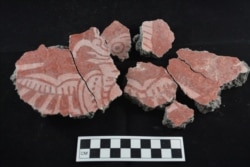The remains of artwork found at what was once the largest city in the Americas has added to evidence that even commoners who lived there enjoyed the finer things in life.
Each year, millions of travelers visit the huge pyramids and other structures that made up the city of Teotihuacan, about 48 kilometers north of present-day Mexico City.
The newly discovered art was found on the city’s southern edge, far from the center and far from where visitors explore today.
Boston University scientist David Carballo discovered the art. The large, brightly colored pictures, or murals, were painted on three buildings he began excavating in July. He said, “We’re now finding that life on the periphery was pretty good.”
The paintings show flowers and singing birds. Carballo said it was surprising to find such works so far away from Teotihuacan’s center.
Carballo and his team have also found other signs of wealth nearby, including a stone mask, seashells from Mexico’s Pacific and Gulf coasts and jade stone.
The mural discoveries point to a very different path taken by Teotihuacan compared to other ancient civilizations. The city was most successful from about 100 B.C. to 550 A.D.
At the time, daily life in Mayan cities, ancient Rome and ancient Egypt was marked by a small, powerful group of people controlling poor or enslaved masses. But in Teotihuacan’s case, most of its estimated 100,000 people were treated well.
Scientists believe that a successful craft-based economy made the city rich. Near the murals, Carballo and his team unearthed what would have been a busy workshop. Workers there likely produced some 200,000 sharp tools made of volcanic glass.
In an area of the city called La Ventilla, another part of Teotihuacan equality can be observed: multi-family, stone housing centers where over 90 percent of the city's people lived. Teotihuacan has more than 2,000 such centers.
The narrow streets of these centers of housing suggest a dense city existence. The centers had water removal systems, open-air spaces and murals.
Ruben Cabrera is an archaeologist who has long led excavations at La Ventilla. He said Teotihuacan’s mass housing is not found elsewhere in ancient times. He said it shows there was less inequality in the city than in most other places.
“It wasn’t as pronounced as, say, Rome or other places where there was a dominant group and a dominated group,” he said.
No evidence of slavery has been found in more than 100 years of digs there, he noted.
Arizona State University archaeologist Michael Smith leads a research laboratory at Teotihuacan. He measured wealth of the city based on its home sizes. The measurement is called a Gini score.
A 1.0 measure means a single household owns everything and zero represents total equality. Teotihuacan’s Gini score came in at 0.12. Smith said that shows an extremely low level of inequality for a pre-industrial society.
“My first reaction was: ‘This is a mistake,’” he said.
Smith compared digs at Aztec sites founded more than 1,000 years after Teotihuacan’s collapse. Each Teotihuacan house had about 200 square meters of living space. Aztec houses were generally much smaller -- about 25 square meters.
Also, burial data gathered by Carballo shows that Teotihuacan’s commoners grew to a height similar to its wealthy and powerful people. Males buried in the centers of housing were less than one centimeter shorter than those buried near the city’s central Moon Pyramid.
By comparison, commoners have been found to be six to nine centimeters shorter than the rich in ancient Greece and Egypt.
I’m Caty Weaver.
The Reuters news agency reported this story. Ashley Thompson adapted it for VOA Learning English. Caty Weaver was the editor.
_______________________________________________________________
Words in This Story
commoner - n. a person who is not a member of the nobility
pyramid - n. a very large structure built especially in ancient Egypt that has a square base and four triangular sides which form a point at the top
periphery - n. the outside edge of an area : the area that surrounds a place or thing
excavate - v. to uncover (something) by digging away and removing the earth that covers it
craft - n. a job or activity that requires special skill
pronounced - adj. very noticeable
dominant - adj. more important, powerful, or successful than most or all others










